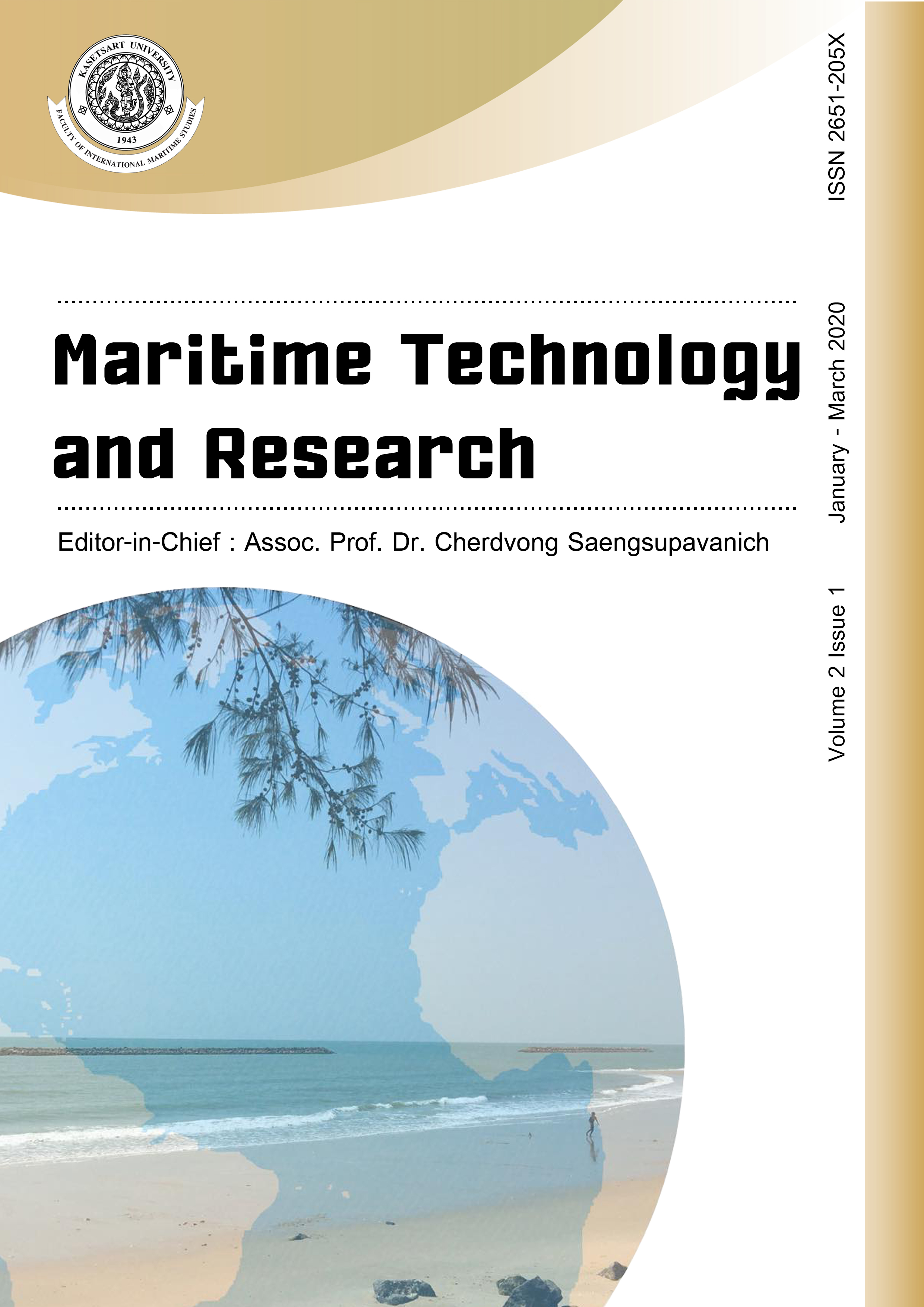Roughness coefficient of polyurethane-bonded revetment
DOI:
https://doi.org/10.33175/mtr.2019.177366Keywords:
Coastal protection structure, Coastal erosion, Alternative revetment, Polyurethane revetmentAbstract
This article analyzed the roughness coefficient of polyurethane-bonded revetment (PBR) by laboratory testing. A wave basin was constructed, with a regular wave generator installed. Three types of revetment were constructed at the same time in the wave basin. Scales were painted on the revetments. Video cameras were installed to record the wave run-up. Measurments of wave height and wave period during the tests were not necessary, since a run-up estimation was entirely based on a linear relationship. The PBR’s roughness coefficient could be interpolated from those of rock and concrete revetments. Three revetment slopes were tested. The roughness coefficient of the PBR was found to be in the range of 0.632 - 0.674, with a standard deviation of 0.042 - 0.053. Following this identification of the roughness coefficient of PBR, coastal engineers can now design revetment crest elevations with confidence.
References
Battjes, J. A. (1974). Computation of set-up, longshore currents, run-up, and overtopping due to wind-generated wave. Report 74-2, Committee on Hydraulics, Department of Civil Engineering, Delft University of Technology, Netherlands.
Cao, W., & Wong, M. H. (2007). Current status of coastal zone issues and management in
Cellone, F., Carol, E., & Tosi, L. (2016). Coastal erosion and loss of wetlands in the middle Río de la Plata estuary (Argentina). Applied Geography 76, 37-48. doi:10.1016/j.apgeog.2016.09.014
Cicin-Sain, B., & Knecht, R. W. (1998). Integrated coastal and ocean management: Concepts and practices. Washington DC, USA: Island Press.
de Waal, J. P., & van der Meer, J. W. (1992). Wave run-up and overtopping on coastal structures. In Proceedings of the 23rd International Coastal Engineering Conference. American Society of Civil Engineers, pp. 1758-1771.
Fitton J. M., Hansom, J. D., & Rennie, A. F. (2016). A national coastal erosion susceptibility model for Scotland. Ocean & Coastal Management 132, 80-89. doi:10.1016/j.ocecoaman.2016.08.018
Houwing, E. (2000). Morphodynamic development of intertidal mudflats: Consequences for the extension of the pioneer zone. Continental Shelf Research 20(12-13), 1735-1748. doi:10.1016/S0278-4343(00)00045-5
Liebisch, S., Huerta, J. C. A., Kortenhaus, A., & Oumeraci, H. (2012). Bonded porous revetments: Effect of porosity on wave-induced loads and hydraulic performance. Coastal Engineering Proceedings 33, 1-15. doi:10.9753/icce.v33.structures.45
Lin, J. (1996). Coastal modification due to human influence in south-western Taiwan. Quaternary Science Reviews 15(8-9), 895-900. doi:10.1016/S0277-3791(96)00060-1
Saengsupavanich, C. (2013). Erosion protection options of a muddy coastline in Thailand: Stakeholders’ shared responsibilities. Ocean & Coastal Management 83, 81-90. doi:10.1016/j.ocecoaman.2013.02.002
Saengsupavanich, C. (2017). Coastal revetment design process in Thailand. WIT Transactions on the Built Environment 170, 33-44. doi:10.2495/CC170041
Saengsupavanich, C., Seenprachawong, U., Gallardo, W. G., Shivakoti, G. P. (2008). Port-induced erosion prediction and valuation of a local recreational beach. Ecological Economics 67(1), 93-103. doi:10.1016/j.ecolecon.2007.11.018
Sudara, S. (1999). Who and what is to be involved in successful coastal zone management: A Thailand example. Ocean & Coastal Management 42(1), 39-47. doi:10.1016/S0964-5691(98)00084-2
US Army Corps of Engineers. (2006). Coastal engineering manual. Washington DC, USA.
van Oorschot, J. H., & Angremond, K. (1968). The effect of wave energy spectra on wave run-up. In Proceedings of the 11th International Coastal Engineering Conference, American Society of Civil Engineers, pp. 886-900.
van Steeg, P., Breteler, M. K., & Provoost, Y. (2016). Large-scale physical model test to determine influence factor of roughness for wave run-up of channel shaped block revetments. In Proceedings of the 6th International Conference on the Application of Physical Modelling in Coastal and Port Engineering and Science, Canada, pp. 1-10.
van Steeg, P., Joosten, R. A., & Steendam, G. J. (2018). Physical model tests to determine the roughness of stair shaped revetments. In Proceedings of the 3rd International Conference on Protection against Overtopping, UK, pp. 1-8.
Williams, A. T., Rangel-Buitrago, N., Pranzini, E., & Anfuso, G. (2018). The management of coastal erosion. Ocean & Coastal Management 156, 4-20. doi:10.1016/j.ocecoaman.2017.03.022
Downloads
Published
Issue
Section
License
Copyright: CC BY-NC-ND 4.0








